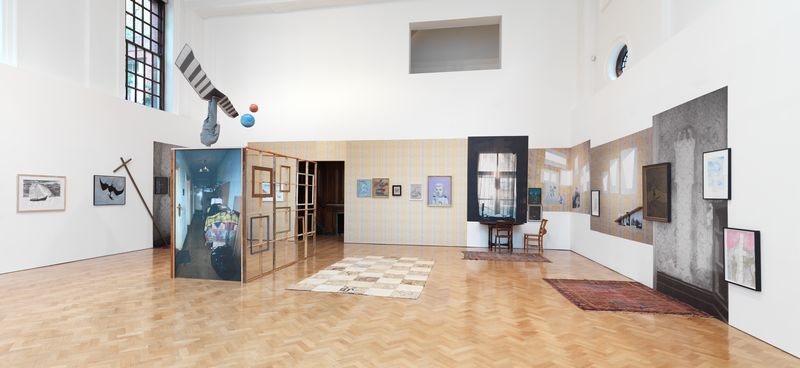
Andy Hope 1930
air tsu dni oui sélavy
20 March - 9 May 2009
London
Andy Hope’s art constructs a shadow universe that is populated by phantoms and superheroes and is full of preternatural occurrences. Time is out of wrack, bendable: home to a history that never happened. Visitors to air tsu dni oui sélavy encounter a tableau that mixes the real with the fantastical. Second-hand chairs and a table, carpets and a figure scaling an upside-down staircase act like cryptic clues, props in a stage set that announce the artificiality of the setting whilst furnishing evidence of its lived existence. Yellow retro wallpaper marches across half of the gallery, the backdrop to an ensemble of homemade Malevich images, aged personal snapshots and new paintings and drawings by the artist, which punctuate and add a further layer to the fiction spun by the installation. Details of the montage include a large photograph of a window, its frame a dark cross against the light, and a photograph showing the ghost of a grandfather clock, silhouetted in negative against grimy walls. The image is a still from ‘Return to Glennascaul’ (Hilton Edwards, 1951), a ghost story in which Orson Welles, playing himself whilst taking a break from the filming of ‘Othello’, becomes embroiled in time travel. This game of negatives intensifies with the Malevich pictures whose famous geometric shapes have been sliced out through the wallpaper to reveal the gallery wall. Cutting through layers of artifice, these doctored Maleviches are white on white, as though what the Russian Supremacist declared to be inventions from the future can now no longer be seen.
Through its traces of lived environments this exhibition conjures the ghosts of several past shows of Andy Hope 1930: ‘Sweet Troubled Souls’ (Silverbridge, Paris 2007) in which he let the scarred walls left by the location’s previous tenancies to instill disquiet in the thirteen women in his paintings; and particularly ‘Phantom Gallery’, (simultaneously at Zürich and Sunset Boulevard, LA 2008), wherein the manufactured marks and stains found within what looked to be former living spaces testified poignantly to the imaginary pasts of previous occupants. In air tsu dni oui sélavy Hope constructs a similar time jinxing fraud: the details of its interior bring back to life ‘c/o Puschmann’, a 1996 exhibition for which he moved much of the contents of a thrift store to a Munich art space, inviting artists and friends to exhibit and sell their own works amidst the bric-a-brac. This also featured copies of the Malevich paintings, revisiting in turn ’0.10 – The Last Futurist Exhibition of Pictures’ of 1915.
Andy Hope 1930 is primarily interested, as the writer Roberto Ohrt has pointed out, in creating ‘a lacunae in historical logic’, an ambition quite as fabulous as the comic book protagonists that regularly make an appearance in his work and whose presence announces that a fiction is being spun. He plays with the pitfalls of grand aspiration: the contradiction between the omnipotent superhero and his two-dimensional confinement, and the avant-garde’s inevitable succumbing to tradition.
The exhibition continues upstairs with a dense hang of new paintings and drawings in The American Room.
Installation views


Related Content
Current Exhibitions
1 / 12































